- Know all about worship of Sun God and Surya Devata iconography in north and south India along with pictures.
The Sun causes day and night on the earth,
because of revolution,
when there is night here, it is day on the other side,
the sun does not really rise or sink.-Aitareya Brahmana III. 44 (Rigveda)
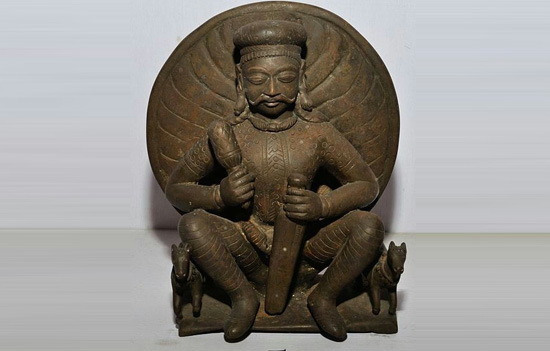 Surya (Bronze), 1st-2nd c. CE- Kushan Period, Government Museum, Mathura.
Surya (Bronze), 1st-2nd c. CE- Kushan Period, Government Museum, Mathura.
 Surya 12th
CE Hoysaleswara Temple Haleebeedu, KA Photo by Jay Shankar.
Surya 12th
CE Hoysaleswara Temple Haleebeedu, KA Photo by Jay Shankar.
The journey of Surya deva or the Sun god, the most prominent
one among the other celestial luminaries, has been a long one in the arena of
India history. As seen from the study of other ancient cultures and
religions, sun has been an object of reverence and worship from the start of
human settlements, and though the Harappan scripts still remain undecipherable,
it would not be very surprising if the circular disc seen in many of its seals
and tablets symbolised the sun. While there are very little available
archaeological evidences to determine the nature of sun worship among the
pre-historic Indians, in the context of literary evidences it is found that the
Vedas are filled with praises for this life sustaining celestial luminary.
In the Rig Veda there are many mentions of Surya and his different aspects, Savitr, Pushan, Bhaga, Vivasvan, Mitra, Aryama, and Vishnu. Savitr, referred to the abstract qualities of
the sun, mentioned him as the stimulator of everything on earth (sarvasya prasavita- Nirukta). Pushan shows him as a pastoral god, with a
focus on the beneficial effects of the sun.
Bhaga, as per Yaska, presides over the forenoon, is a
distributor of wealth, and is often associated with his Iranian counterpart
Baga or Bagho. Vivasat, who could have represented the rising sun, is referred
to in the RV as the first sacrificer and ancestor of human beings. His counterpart
was seen in the Avestan Vivanhant, who had first prepared the haoma
(homa). Mitra and Aryama both had their Iranian counterparts in Mithra and
Aryaman. From a study of the Vedic hymns it becomes clear that the highly
revered atmospheric/cosmic deity later turned into the god of light with the
name Surya.
Among the solar deities named above, Vishnu later became a
part of the Bhagavatam creed that led to the development of the powerful
Vaishnavism sect. These saura or solar deities, along with few others, such as
Daksa, Amsa, Martanda, etc. came to be known as the Adityas.
While in the early Vedas the number of the Adityas varied
from 6 to 8, in the later Vedas the number of Adityas was fixed at 12. In Sathpatha Brahmana one verse mentions the number of Adityas as
8 where Martanda is included; however, in two other passages in the same book
the number increases to 12, identifying twelve months with the twelve Adityas.
The Epics and the Puranas stick to the 12 Adityas thereafter.
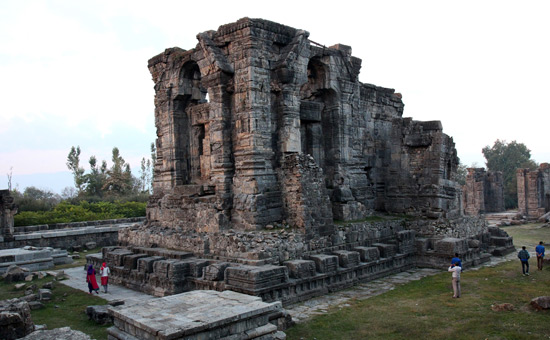 Martanda Surya Mandir, Jammu and Kashmir.
Martanda Surya Mandir, Jammu and Kashmir.
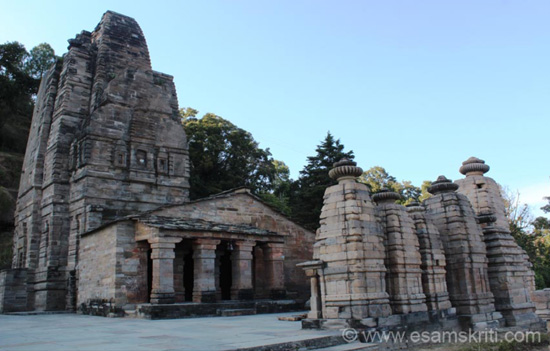 Surya Mandir Almora, Uttarakhand.
Surya Mandir Almora, Uttarakhand.
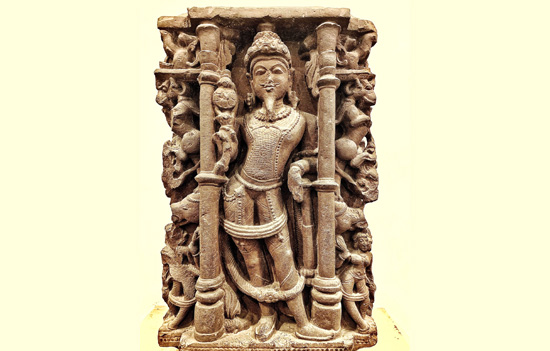 Martanda.
Martanda.
Full caption-He is the eighth and last of
the early Vedic solar deities known as Adityas. In the Rigveda, it is
said that: “Eight are the Sons of
Aditi who from her body sprang to life. With seven she went to meet the Gods
she cast Martanda far away. So with her Seven Sons Aditi went forth to meet the
earlier age. She brought Martanda thitherward to spring to life and die again”
(Ref: Chapter-10, Verse-72, The Hymns of the Rigveda, translated
by Ralph T. H. Griffith). Although
some hymns in the Rigveda mention him as one among the other Adityas (forms of
Surya), but it is evident from the verse above that Aditi had forsaken her
eighth and the last son. Martanda is linked to the dead sun, or a sun that has
sunk below the horizon (Arctic
Home in the Vedas, B G Tilak, 1903).
The worship of the 12 Adityas along with the nine planets or
navagrahas occupied an important position in the religious lives of the
Indians. The navagrahaas are Ravi (sun), Soma (moon), Mangala, (Mars), Budh
(mercury), Brhaspati (Jupiter), Sukra (Venus), Sani (Saturn), Rahu and Ketu
(the ascending and descending phase of the moon).
The navagrahas are worshipped to remove the baneful effect of
the planetary positions in one’s rashi by pleasing these deities (as per the
grahayaya or svastyayana vidhi); a practice that still runs strong in
India.
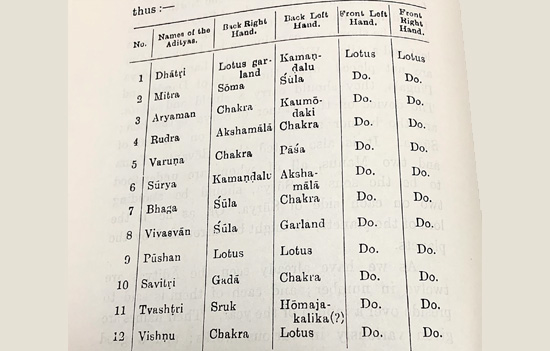 The 12 Adityas as
described in the Visvakarma-Sastra. (Source: T.A.G Rao, Vol I, part II, p. 310)
The 12 Adityas as
described in the Visvakarma-Sastra. (Source: T.A.G Rao, Vol I, part II, p. 310)
Also
read Worshipping
the Navagrahas and Navagraha
Temples in Tamil Nadu
As per the Bhavisya, Varaha, and Samba Puranas, after the great battle of Kuruksetra, Samba,
one of Krsna’s sons, developed leprosy, and he was advised that in order to
cure this dreadful disease he had to worship Mitra, the Sun-god. For that,
Samba invited some of the Brahmanas from Sakadvipa (Scythia) to perform the
Surya puja who were commonly known as Magas or Bhojakas. These Saura Brahmanas
also worshipped the images of Brahma, Visnu, Mahesvara, the Matrikas, Niksubha
and Rajni (the consorts of Surya), the two Asvinidevtas, Agni, and Dandanayaka
(attendants of Surya), Mahasveta, Vinayaka, and Kuvera.
Thus, we find written in the Bhavisya Purana (Brahmaparva)
that a temple of the Sun-god should also have places reserved for the images of
these gods and goddesses. These Persian sun priests known as Magi (Magas in
Indian terminology), were entitled to ceremonially instil Surya murtis in
temples, as per the Brhatsamhita. This close association of the Iranian form of
sun worship with the north Indian form led to a re-orientation of the
Surya iconography in north India.
 Surya, Paramara, 8th c.
CE, central India. National Museum, Delhi.
Surya, Paramara, 8th c.
CE, central India. National Museum, Delhi.
It has been observed that various Rig Vedic verses dedicated
to Surya tend to have influenced many of his iconographic traits seen in the
later periods. In many of the Vedic verses Surya has been described as moving
on a chariot drawn by one, or by four, or by 7 ruddy horses. In other verses we
find him mentioned as “divya suparna Garutman” or a beautiful celestial bird, while one verse
describes him as a white brilliant horse.
From these descriptions originated the later vahana of Vishnu
as Garuda, and the horse mount of Surya named as Tarkasya. Surya retained his
importance in the Epics and Puranas, and this is evident in the Mahabharata
where we find that he is termed as Devesvara or the ‘Lord of gods’; and this
continued well into the Gupta period. The sun worshipers who were known
as the Sauras believed that the Surya was the supreme entity and the creator of
the world (surya atma jagatastasthu-sasca). There were 6 classes of the Sauryas, and each
group wore their own namam (distinctive symbols) drawn with red sandalwood
paste and red flowers as garlands and recited the Suryasataka.
 Surya, Central India, 10-11th
century CE, sandstone-Matsuoka Museum of Art – Tokyo, Japan.
Surya, Central India, 10-11th
century CE, sandstone-Matsuoka Museum of Art – Tokyo, Japan.
After Samba decided to worship Surya as per the Sakadvipi
(east Iranian/Persian) way, he built a Sun temple at Mulasthanapura (modern
Multan) on the banks of the Chandra Bhaga. This temple is found described in
details in the writings of Hiuen Tsang and Arab geographers, such as, Al
Ishtakhri, Al Edrisi, etc. Remains of other sun temples still extant are in
Modhera (Gujarat), Konark (Odisha), Rajasthan, and other parts of northern
India, including the Himalayan states.
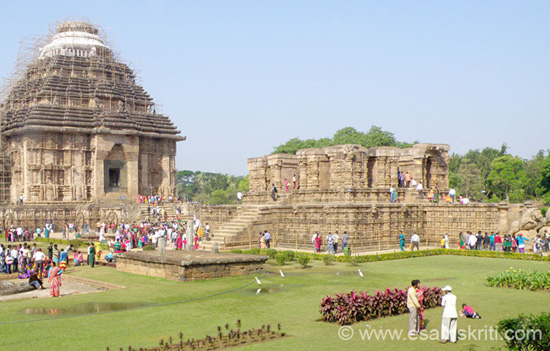 Sun Temple Konarak.
Sun Temple Konarak.
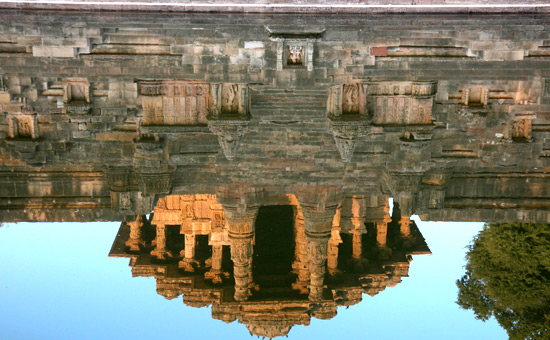 Surya Mandir Modhera.
Surya Mandir Modhera.
From an inscription it has been learned that during the reign
of Mihirikula, the Hun king, a sun temple at Gopadri (Gwalior fort) was built
by a devotee named Matrcheta. The Indor (UP) copper plate inscription tells us
of a sun temple built in that place during the time of Skandagupta, and in
the Mandsor stone inscription there is a mention of an earlier sun temple built
by the silk weaver’s guild during the reign of Skandagupta’s father. The
large number of sun temples spread across the North and NW parts of India
shows the widespread popularity of sun worship that lasted well into the
medieval times.
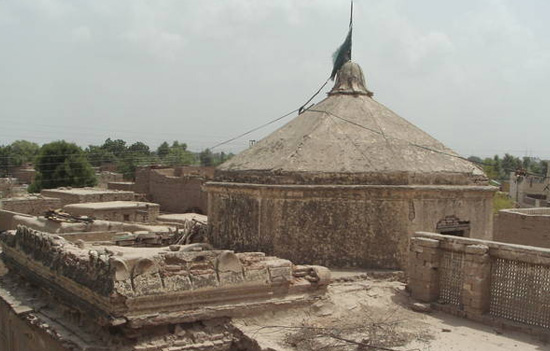 Ruins of what was once the
Sun temple in Multan. Some Puranas also talk of another sun temple in Mathura
built by Samba.
Ruins of what was once the
Sun temple in Multan. Some Puranas also talk of another sun temple in Mathura
built by Samba.
Source
of picture
 Sun
temple known as Padmanabha temple in Jhalraptan, Rajasthan.
Sun
temple known as Padmanabha temple in Jhalraptan, Rajasthan.
The following description of the Mitra or Sun-god is
given in the Visvakarma Silpa :
“His
great chariot has one wheel and is drawn by seven horses ; He has a lotus in
each
of his hands, wears an armour and has a shield
over his breast, has beautiful straight hair, is surrounded by a halo of light,
has (good) hair and apparel, is decorated with gold (ornaments) and jewels, has
on his right side the figure of Niksubha and on the left that of his Rajni with
all sorts of ornaments and whose hair and necklace are bright. His chariot
mentioned above is called by the name of Makaradhvaja. He wears a crown. The
figure is surrounded by a halo. Danda (Skanda) is represented as one- faced and
Skanda as having a bright conch-shell. These two figures with the form of man
are placed in front. Varcha on a lotus is placed on a horse. His body is
represented as lustrous and he is the one giver of light to all the worlds. A
Surijamandala is to be made by placing nutmeg and Vermillion. He (Mitra) has
four hands or only two with jewels adorning them. In both of his hands there
are lotuses. He is seated on a chariot drawn by horses of variegated; colour.
His two gate-keepers Danda (Skanda) and Pingala (Agni) have swords in their
hands” (translated by Nagendranath Vasu, in “Archaeological survey of
Mayurbhanj,” also ref: Visvakarma Silpa MS. pp 30a-31b).
The Bhavishya Purana further states that the Asvinidevatas may
also be added as standing on each side of Surya, along with the other figures
mentioned in the Visvakarma silpa.
According to Suprabhedagama, Surya should be shown with two hands holding a
lotus each, while Vishnudharmottora (of a later date) says
the deity can be shown with four arms. The hands with closed fists
carrying lotus flowers should reach up to the shoulder level. The deity should
have a kantimandala or halo around his head; he should be
bejeweled with earrings, necklace, and a yagnopavita; and the body should be covered with a coat in
the northern style and he should be wearing boots (udicyavesha). He should be placed on padmapitha (lotus seat),
or be placed on a single wheeled chariot pulled by 1, 3, 4, or 7 horses, and
driven by Aruna.
On the right side of Surya there should be Usa,
and on his left side would be Pratyusa, both shown in the act
of shooting arrows, symbolising the various aspects of dawn dispelling darkness
(represented as demons). On his right should stand Pingala or Agni carrying a
pen and an inkpot; while on his left side should stand Danda, carrying a staff.
Other attendants would include his four wives: Rajni, Niksubha, Chaya, and
Suvarcasa. Besides these figures, his four sons Yama, Revanta, and the two
Manus may also be shown accompanying him (Visnudharmattora). Sometimes miniature figures of the other eight
grahas are also depicted along with the other accessory figures.
Differences in the North and South Surya
Iconography
The South Indian Suryas, which remain free from the Persian/ Iranian
influences, have their hands raised to the level of their shoulders, and
they hold half-blossomed lotuses almost in bud stages. The legs and feet are
bare (that is, he wears no boots), and there is an udarabandha on
his waist.
The North Indian Suryas hold their hands at the hips
or elbow levels, and the hands carry long stemmed lotuses in full bloom that
reach up to the shoulders. Northern Suryas wear boots (upanat-
upanat padayuglam), and there is a tight fitting coat of mail on the upper
torso, and the two together make up the Surya’s northerner’s dress known as udicyavesha; his elaborate waist girdle is
known as avyanga (different from
the south’s udarabandha).
The udicyavesha and avyanga are among the more prominent
Iranian/Persian influences on the northern Surya imagery.
Aruna and the seven horses are often
absent in the southern Surya murtis,
and the number of accompanying figures are also less in southern depictions.
(Rao, Elements of Hindu Iconography)
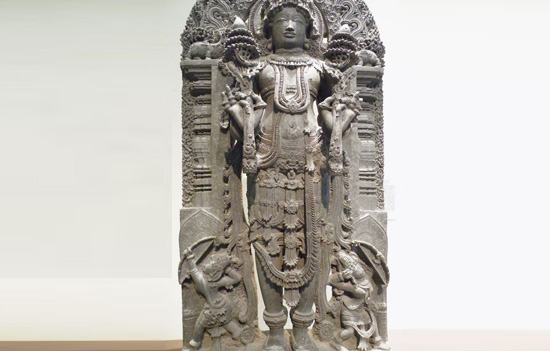 A very elaborate South Indian Surya from Karnataka, 13th c. CE.
A very elaborate South Indian Surya from Karnataka, 13th c. CE.
Surya in Indian art
Surya was depicted in Indian
art through different symbols prior to the development of a worship-based group
or sect centering around the sun. The symbols were mainly used during sacrifice
rituals and they mainly in the form of wheels, lotus, round golden plate etc.,
and it is these symbols that we see in the earliest cast and punch marked coins
from India.
Coins by the Pancala Mitra kings like Suryamitra and
Bhanumitra are seen with the solar discs on a pedestal. Surya in his
anthropomorphic form did not take long to develop, and in the earliest
remaining Surya images that we see, is a 1st c. BCE stone railing from Bodh
Gaya where we find him riding his ekachakra chariot drawn by four horses. There
are Usa and Pratyusa on his two sides, driving away demons or asuras of
darkness (symbolised by two male busts on two sides).
Another similar depiction of Surya is seen in the
Bhaja cave and is also from 1st c. BCE. The early Surya depictions from all
across India show that the iconography of this deity was largely the same as
seen in Bhaja caves and Bodh Gaya railings. This form of depiction, however,
soon saw modifications in the Surya icons (likely from late 1st or 2nd c. CE),
owing to the influence of Persian Maga priests, and gained greater prominence
from the Gupta period.
Given below are Surya images over many centuries (from
BCE era to 13th c. CE ) and they give a very good idea of how the Surya
iconography changes over time, especially after the Persian Maga influence (north, west, and east Indian murtis):
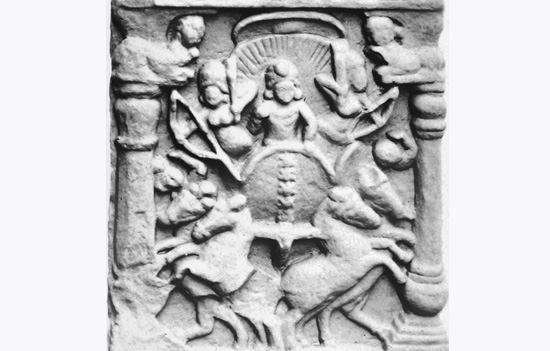 Bodh Gaya quadriga relief
of Surya riding between pillars (detail of a railing post), 2nd–1st century
BCE.
Bodh Gaya quadriga relief
of Surya riding between pillars (detail of a railing post), 2nd–1st century
BCE.
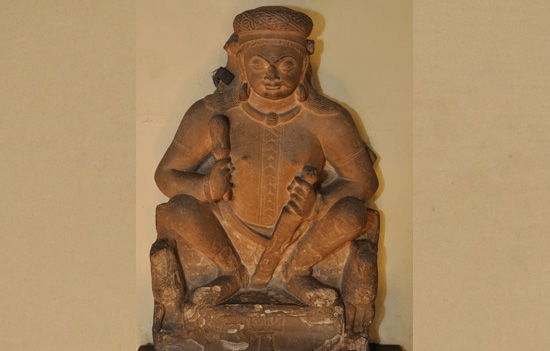 Surya, 1st-2nd c. CE – Kushan Period, Kankali Mound –Mathura.
Surya, 1st-2nd c. CE – Kushan Period, Kankali Mound –Mathura.
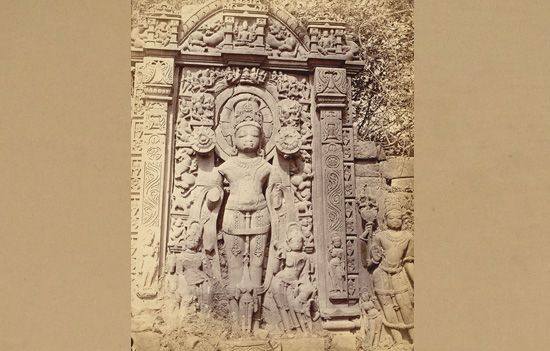 Sculpture of Aditya (Surya), and and the
navagraha, or nine planets, belonging to the late Gupta period, found in
Garhwa, Prayagraj, 1870s photograph.
Sculpture of Aditya (Surya), and and the
navagraha, or nine planets, belonging to the late Gupta period, found in
Garhwa, Prayagraj, 1870s photograph.
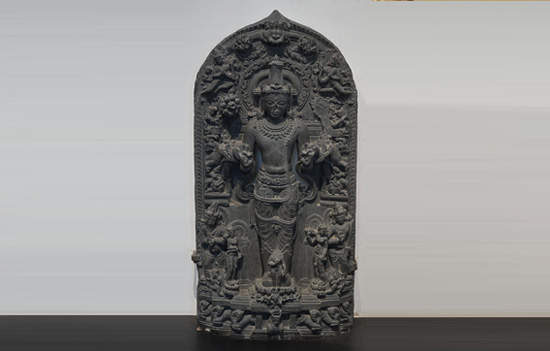 Surya – Basalt – Circa 12th Century CE – Rajshahi – Bangladesh, now in Indian Museum Kolkata.
Surya – Basalt – Circa 12th Century CE – Rajshahi – Bangladesh, now in Indian Museum Kolkata.
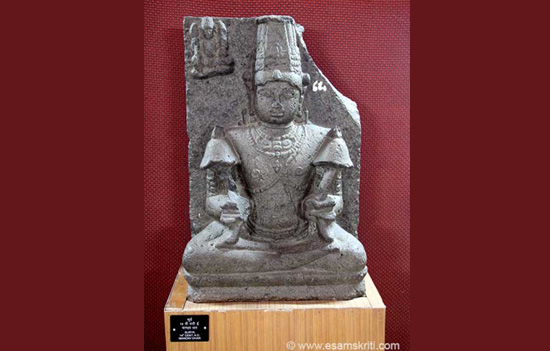 Surya 14th century, Art Gallery Dhar Fort.
Surya 14th century, Art Gallery Dhar Fort.
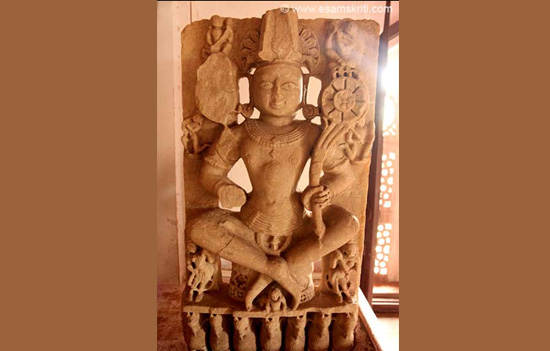 Surya, Art Gallery, Mandu, Madhya Pradesh.
Surya, Art Gallery, Mandu, Madhya Pradesh.
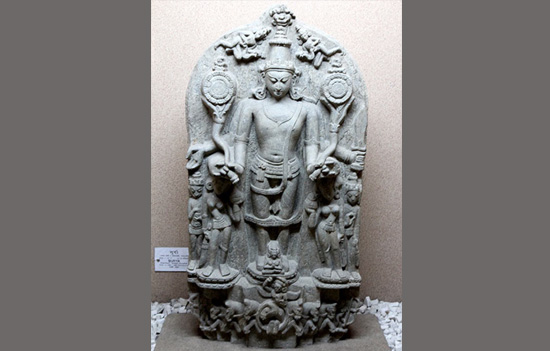 Surya Ambari, 13-14th century, State
Museum Guwahati.
Surya Ambari, 13-14th century, State
Museum Guwahati.
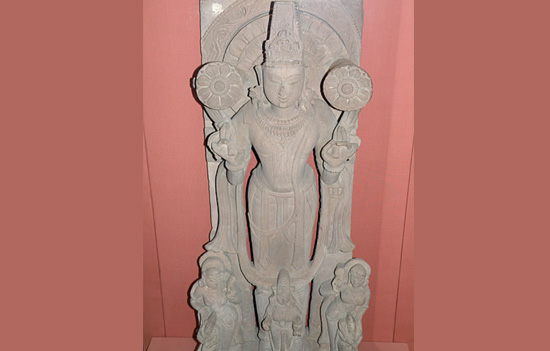 Surya Central India, 11th century. British
Museum, London.
Surya Central India, 11th century. British
Museum, London.
References
1. Anand K. Coomaraswamy, Introduction to Indian art.
2. TAG Rao, Elements of Hindu Iconography.
3. Stella Kramrisch, The Hindu Temple.
4. A Comprehensive history of India (ed. RC. Mazumdar), “Indian Iconography-
Surya (300-985 AD)” by KK Dasgupta.
To read all articles by author
Author studies
life sciences, geography, art and international relationships. She loves
exploring and documenting Indic Heritage. Being a student of history she likes
to study the iconography behind various temple sculptures. She is a well-known columnist
- history and travel writer. Or read here
Article
was first published on author’s blog and Here and pictures are courtesy and
copyright author except the ones from esamskriti.